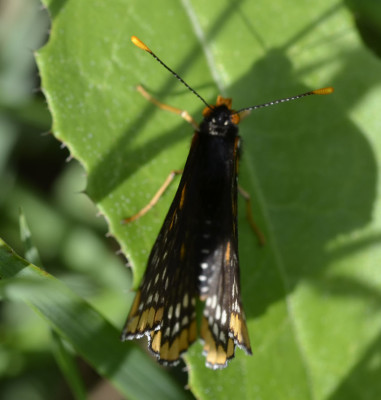There’s a meadow of what gardeners would call “weeds” at Riverwood Conservancy in Mississauga, Ontario. I like to prowl through it as often as possible especially on a sunny morning when the air is still cool and the butterflies, dragon and damselflies are often basking in the sun to warm up for the busy day ahead. In late June, I found this striking brown and orange butterfly taking advantage of some solar power.
What’s With the Orioles and Checkerspots?
This is a Baltimore Checkerspot, according to my new favourite resource book, the ROM Field Guide to Butterflies of Ontario. (Thanks, Mom and Dad!) Fortunately for me, since my id skills are pretty weak, it says there are no similar butterflies to confuse the issue.
I found the orange antenna tips made for quite a nicely coloured coordinated look!

The dark shadows from the grass make it difficult to see its head but I try very hard not to spook my subjects as they are basking from need, not for my amusement, so I try to leave them as I found them. Moving some grass aside would likely have forced the butterfly to take flight.
I wasn’t sure if the Baltimore Checkerspot was named for the American city or for a person.
According to the Maryland Department of Natural Resources website, it was named for George Calvert, Lord Baltimore, because the orange and dark colours suggest those on his heraldic shield.

Even with wings partially closed it’s a noticeable butterfly. (I had hoped to get a side view but couldn’t without going off trail.)
(I would guess that the orange and black colouring of the Oriole led to the Baltimore Oriole name too.)
When Should I Look for Baltimore Checkerspots?
According to BugGuide.net they have had reports of the butterflies in June and July. This matches well with the ROM Guide which also notes that they over-winter as caterpillars.
The very young caterpillars prefer to feed on White Turtlehead plants. I haven’t actually seen any of those plants in the meadow at Riverwood where I saw the butterfly but there may be some further back from the trail. (I don’t go off trail in parks where staying on trail is requested.) I’m pretty sure I’ve seen Turtlehead elsewhere in the park, though, so now I’m starting to keep an eye out for patches.

There was no noticeable Turtlehead in the meadow in my “approach” photos. You can see how vividly the butterfly shows up even from a distance in this partially cropped photo.
There are other plants listed that the caterpillars will eat especially when they are older and presumably more mobile.
I’ll keep looking for both Turtlehead and Checkerspots over the next few weeks. I’d love to have a look at the offspring of this one!
Related Reading
- A Pipevine Swallowtail Visits Lakeside Park
- When Swallowtails Get Annoyed
- What Is This Big Eyed Beetle?
Join In
Do Baltimore Checkerspots brighten up your local park? Please share your sighting with a comment.
